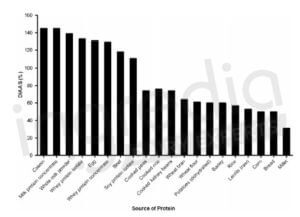What is the perfect protein for the elderly people?
2 October 2019
Some health problems may arise and involve with age, especially at the muscular level. That is why a strength reduction and a muscular loss can appear. In the last article call “what are the protein need of the elderly people?” we emphasize the importance of consuming enough proteins to maintain and strengthen the muscular mass. Then this new article is made to identify the factors to be considered in order to know which proteins best meets elderly people needs.
What is the perfect protein for the elderly people?
The perfect protein does not exist, but some of these are most suitable than others. Animal based proteins should be privileged compared to plant based protein because of their balanced composition of essential amino acidsA and their excellent digestibility. By the way, food balance remains essential. That is the reason why it is recommended that animal based protein represent at least half of the daily protein intake.1 2 3
According to a report from the International Sarcopenia Initiative released in 2004, milk proteins seem to be the protein that best meet elderly people needs.1

How do milk proteins best meet elderly people needs?
In addition to amino acids composition and digestibility, a protein has to meet three requirements to be considered as suitable to supplement elderly diet. Therefore it must:
- Contain enough essential amino acids, especially BCAAB and more precisely Leucine ;
- Be easy to consume4 ;
- Sustainably promote muscle protein synthesis.5
Milk proteins meet these three criteria.6 7
Why are essential amino acids and BCAAs so important?
It is important to choose proteins high in essential amino acids in order to maximize muscle protein synthesis.8 Best sources of these ones are proteins which meets our organism needs with the best digestibility. This is explained in more detail in the article “How to characterize protein quality?”. The DIAAS is an indicator which takes into consideration the amino acid composition quality and there own digestibility. The higher the DIAAS is, the higher the protein quality is.9 Figure 1 is a bar chart representing DIAAS for different protein sources. We can see that milk proteins (casein, milk protein concentrate, whole milk powder, whey protein isolate, whey protain concentrate) have the higher DIAAS among all proteins.10

Figure 1: Quality of different common protein sources expressed with the DIAAS.10
However, it should not be forgotten that overall food intake is reduced for elderly people. Consequently, consumption of all amino acids is also reduced. Therefore, even if essential amino acids should be privileged, non essential ones should not be ignored.
Concerning BCAAs, these are essential amino acids with a positive impact on protein metabolism. They enhanced muscle protein synthesis and reduced degradation.5 Among the 3 different BCAAs we have Leucine. This is one of the most important amino acid to stimulate anabolismC.11 12
Many studies have been conducted to know the ideal dose of this amino acid necessary to stimulate muscle protein synthesis. A first one conducted in 2006 showed that quantity of Leucine necessary to have an optimal anabolic response for people over 60 years old was significantly higher than that required for young adults (respectively 2.8g vs. 1.7g).13
A review about nutritional recommendations of Medical Clinics of North America mentioned a minimum Leucine quantity of 2.2g per meal in order to enough stimulate anabolism.14
It is better to select a high Leucine protein source such as milk proteins. For example, micellar caseins contain 8.5% of Leucine. Therefore, a micellar caseins dose of 30g provides all essential amino acids necessary including 2.6g of Leucine. This is a sufficient dose to enhanced muscle protein synthesis, even for aged muscles.14
Is it really that important to choose easy to consume proteins?
For elderly people, it is necessary to promote anabolism period and limit muscle protein degradation as much as possible.
Overall catabolismD is promoted during periods far from meals, unlike anabolism which is stimulate after protein intake. Therefore it is essential to regularly consume protein.15
However, certain studies show that the most important point remains the total protein amount consume during the day, and not the timing or the distribution.16
At the same time, appetite reduction due to age must be considered. As a consequence, food quantity ingested deceases on average by 25% between the age of 40 and 70. This is the reason why 15 to 38% of the dependent elderly people (i.e. people in nursing home or assisted by a home nurse as a result of their independence loss) are affected by undernutrition in France.17
That is why it could be interested to spread food intake during the day and especially choosing an easy to consume protein source, for example in the form of a drink or a pudding. Milk proteins, particularly micellar caseins, are perfectly adapted for this type of formulation. Different food supplements exist, such as drink with up to 14g of protein in only 100mL of volume. This type of formulation provides a maximum of nutrients in a minimum of volume with a pleasant taste to make the product more palatable.18

Concerning the sustainable anabolism, what does it mean?
First, the protein dose should be sufficient to enhance muscle protein synthesis. The fact that an aged muscle is less responsive to a reduced amount of amino acid compared to a younger muscle has to be considered.19 This topic was explained in more detail in the article entitled “what are the protein need of the elderly people?”.
Secondly, the goal is to limit muscle protein degradation. To do so, two complementary solutions exist: reducing the time between meals and then increasing food intakes, and choose proteins gradually absorbed by the body in order to always have a concentration of blood amino acids higher than basal level.4
Concerning the meal increase, we return to what we described above: an easy to consume protein source remain necessary.4 About gradual absorption, micellar caseins have this property. This has been explain in the article “What is the interest of micellar caseins is sports?”.
Is this the only interest of milk proteins for the elderly people?
No it is not, these are only the main reasons. For example, to speak about an other interest, micellar caseins contain 2.6% of calcium, i.e. 2,600mg/kg! This is an excellent source of calcium which contribute to maintain the bone structure (risk reduction of osteoporosis) and muscle health. The article “what are the protein need of the elderly people?” explain this in more detail.

Did you know?
For elderly, especially people over 60, proteins are not the only nutrient to watch out. Overall food intake is reduced, then nutritional coverage of other nutrient may be lower than the needs, particularly iodine, zinc, omega-3 (EPA and DHA) and, only for women, iron and vitamin C. These data come from a report established by the ANSES in june 2019.20
A food supplement for elderly people should consider some of these nutrients in order to be as complete as possible.
For more information on our milk proteins and our expertise, contact us.
Authors: Rémi Maleterre & Audrey Boulier.
*A [Essential Amino Acids]: Amino acid that the body cannot synthesize. Therefore they must be supplied through the diet.
*B [BCAA, Branched-Chain Amino Acids]: Essential amino acids which correspond to Leucine, Isoleucine and Valine
*C [Anabolism]: Muscular protein synthesis.
*D [Catabolism]: Muscular protein degradation.
________________________________________________________________________________________________
[1] Cruz-Jentoft AJ, Landi F, Schneider SM, Zúñiga C, Arai H, Boirie Y, Chen LK, Fielding RA, Martin FC, Michel JP, Sieber C, Stout JR, Studenski SA, Vellas B, Woo J, Zamboni M, Cederholm T (2014) Prevalence of and interventions for sarcopenia in ageing adults: a systematic review. Report of the International Sarcopenia Initiative
[2] Paddon-Jones D., Leidy H. (2014). Dietary protein and muscle in older persons. Current opinion in clinical nutrition and metabolic care vol. 17, 1:5-11. Epub September 12, 2014. https://doi.org/10.1097/MCO.0000000000000011
[3] Marzetti E., Calvani R., Tosato M., Cessari M., Di Bari M., Cherubini A., Collamati A., D’Angela E., Pahor M., Bernabel R., Landi F. (2017). « Sarcopenia: An Overview ». Aging Clinical and Experimental Research, vol. 29, no 1, p. 11‑17. Epub February 2, 2017. https://doi.org/10.1007/s40520-016-0704-5
[4] Kerksick C.M., Wilborn C.D., Roberts M.D., Smith-Ryan A., Kleiner S.M., Jäger R., Collins R., Cooke M., Davis J.N., Galvan E., Greenwood M., Lowery L.M., Wildman R., Antonio J. and Kreider R.B. (2018). ISSN exercise & sports nutrition review update: research & recommandations. Journal of the International Society of Sports Nutrition, 15:38. Epub August 01, 2018. https://doi.org/10.1186/s12970-018-0242-y
[5] Lacroix M., Bos C., Léonil J., Airinei G., Luengo C., Daré S., Benamouzig R., Fouillet H., Fauquant J., Tomé D., Gaudichon C. (2018). Compared with casein or total milk protein, digestion of milk soluble proteins is too rapid to sustain the anabolic postprandial amino acid requirement. Am J Clin Nutr 2006; 84:1070–9/ Epub January 23, 2018. https://doi.org/10.1556/1646.10.2018.10
[6] Ingredia. Prodiet 87 B Fluid – Nutrition facts . December 11, 2015.
[7] Ingredia. Prodiet 90 S – Nutrition facts . March 18, 2016.
[8] Atherton P.J., Smith K. (2012). Muscle protein synthesis in response to nutrition and exercise. J Physiol, 590(5):1049–1057. Epub January 31, 2012. https://doi.org/10.1113/jphysiol.2011.225003
[9] Report of an FAO Experte consultation. Dietary protein quality evaluation in human nutrition. ISSN 0254-4725 FAO and food nutrition paper 92. 31 March – 2 April, 2011.
[10] Robert R. Wolfe, Update on protein intake: importance of milk proteins for health status of the elderly, Nutrition Reviews, Volume 73, Issue suppl_1, August 2015, Pages 41–47. Epub July 11, 2015. https://doi.org/10.1093/nutrit/nuv021
[11] Imanipour V., Banaiifar A., Mahdi F., Naderi A., Sadeghi M. (2018). The effects of branch-chain amino acids on fatigue in the athletes. Interventional Medicine and Applied Science 2061-5094. Epub March 19, 2018. https://doi.org/10.1556/1646.10.2018.10
[12] J.C. Anthony, T.G. Anthony, S.R. Kimball, T.C. Vary, L.S. Jefferson (2000). Orally Administered Leucine Stimulates Protein Synthesis in Skeletal Muscle of Postabsorptive Rats in Association with Increased eIF4F Formation, The Journal of Nutrition, Volume 130, Issue 2. Pages 139–145. Epub February 01, 2000. https://doi.org/10.1093/jn/130.2.139
[13] C.S. Katsanos, H. Kobayashi, M. Sheffield-Moore, A. Aarsland, R.R Wolfe (2006). A high proportion of leucine is required for optimal stimulation of the rate ofmuscle protein synthesis by essential amino acids in the elderly. Am J Physiol Endocrinol Metab 2006;291(2):E381–7. Epub August 01, 2006. https://doi.org/10.1152/ajpendo.00488.2005
[14] Hope Barkoukis (2016). Nutritions recommendations in elderly and Aging. Practice-base nutrition Care, Medical clinics of North America. Vol 100, number 6, 1237-1250. Pub November 2016.
[15] Poortmans, J.R., Carpentier, A., Pereira-Lancha, L.O., & Lancha Jr., A. (2012). Protein turnover, amino acid requirements and recommendations for athletes and active populations. Brazilian Journal of Medical and Biological Research, 45(10), 875-890. Epub June 06, 2012.https://dx.doi.org/10.1590/S0100-879X2012007500096
[16] I.Y. Kim, S. Schutzler, A.M. Schrader, H.J. Spencer, G. Azhar, R.R. Wolfe, A.A. Ferrando (2018). Protein intake distribution pattern does not affect anabolic response lean body mass, muscle strength or function over 8 weeks in older adults: a randomize-controlled trial. Clinical Nutrition, Vol 37, Issue 2, 488-493. Epub Avril 2018. https://doi.org/10.1016/j.clnu.2017.02.020
[17] V. Pouyet, A. Giboreau, G. Cuvelier, L. Benattar (2015). Les préférences culinaires des personnes âgées vivant en institution : facteurs d’appréciation sensoriels et cognitifs. Cahier de Nutrition et Diététique 2015. Vol 50, n°5, p235-289. Pub November 2015. https://doi.org/10.1016/j.cnd.2015.03.008
[18] Ingredia, Prodiet Fluid. The Innovative Micellar Casein dedicated to high protein beverages. https://www.prodiet-fluid.com/
[19] D. Dardevet, D. Rémond, M.A. Peyron, I. Papet, I. Savary-Auzeloux, L. Mosoni (2012). Muscle wasting and resistance of muscle anabolisme : the « anabolic threshold concept » for adapted nutritional strategies during sarcopenia. The Scientific World Journal, Vol 2012, ID 269531. Epub December 03, 2012. https://dx.doi.org/10.1100/2012/269531
[20] Agence nationale de sécurité sanitaire de l’alimentation, de l’environnement et du travail (ANSES). (2019) Dossier de presse – Repères alimentaires pour populations spécifiques. Consulté le 2 juillet 2019. https://www.anses.fr/fr/content/rep%C3%A8res-alimentaires-pour-les-populations-sp%C3%A9cifiques-enfants-femmes-enceintes-allaitantes